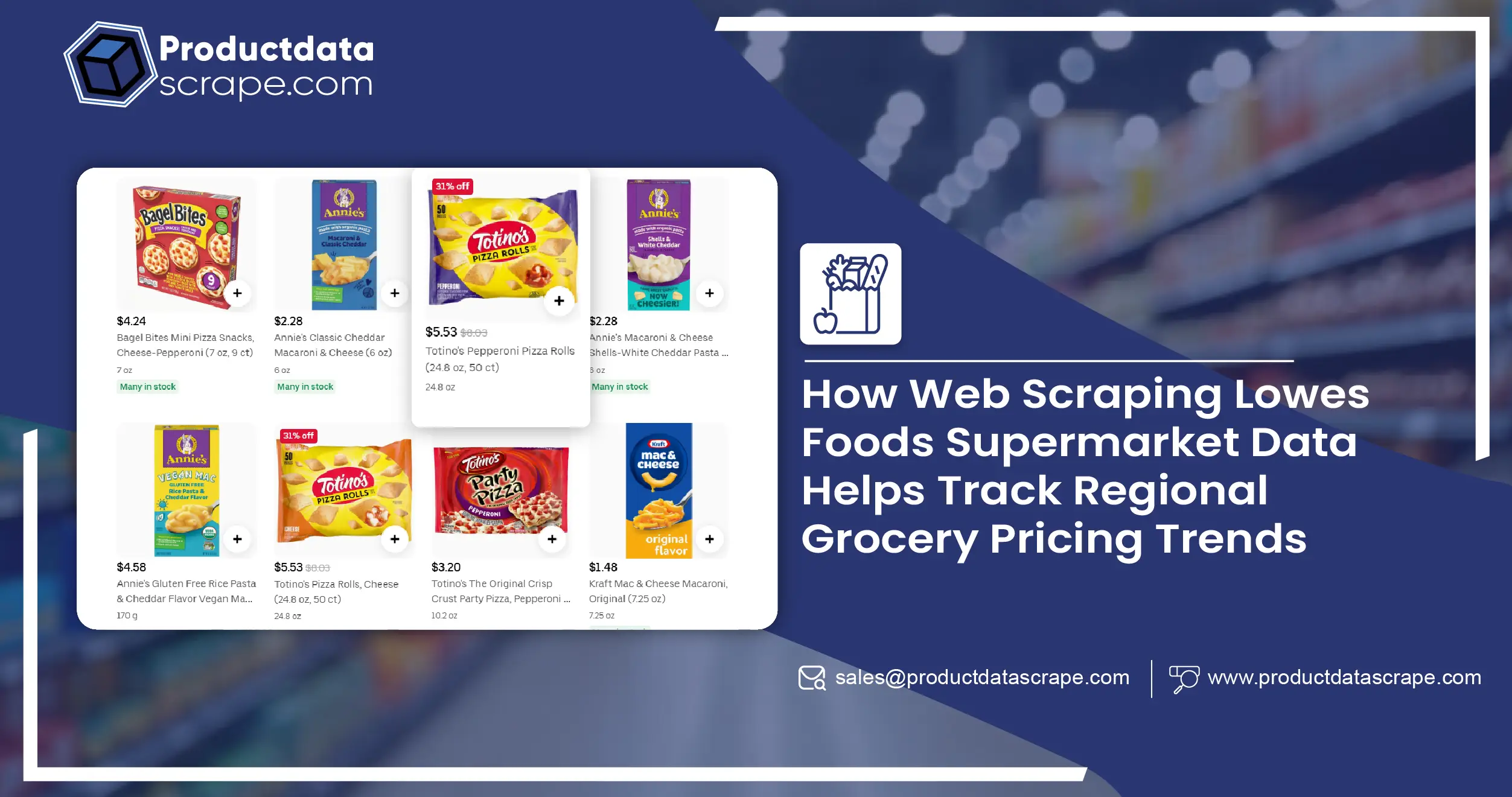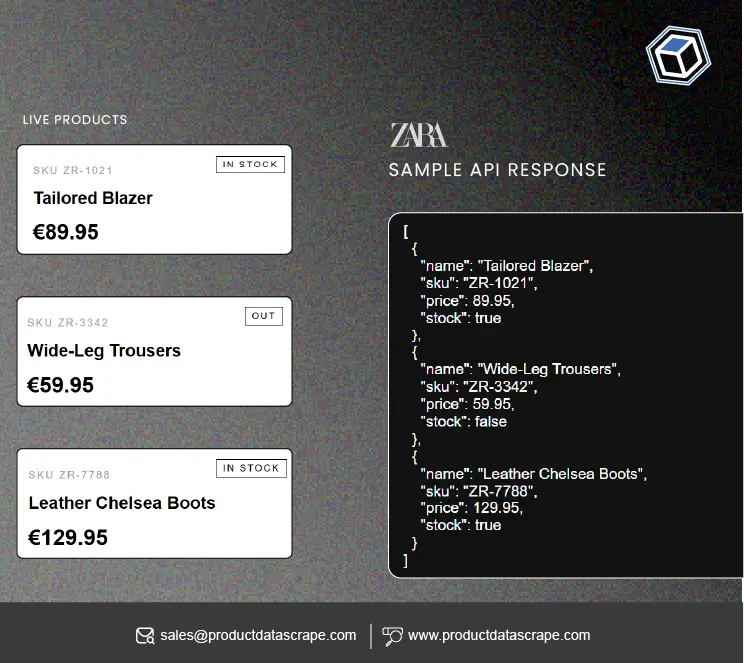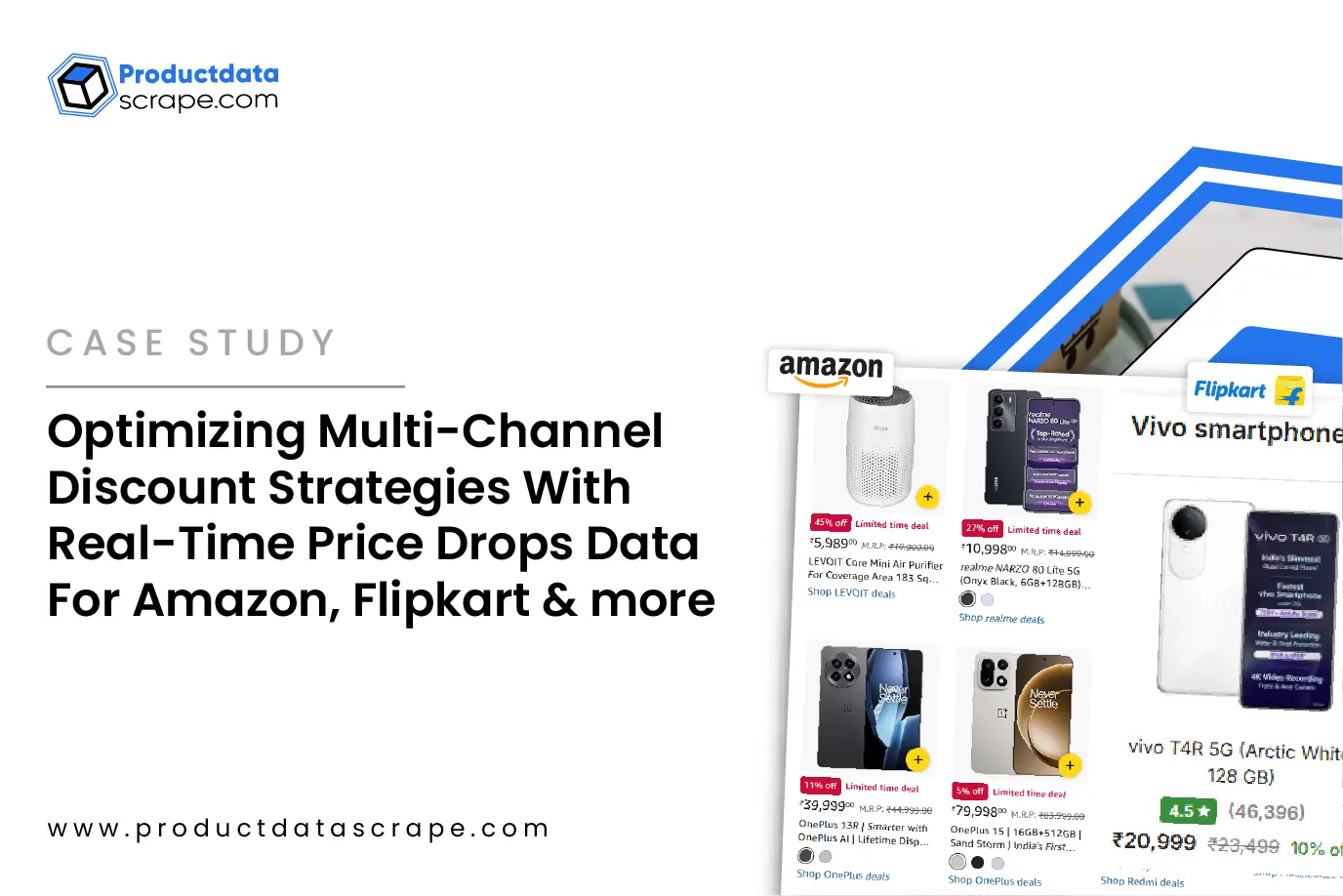
Introduction
In today’s fiercely competitive grocery and FMCG market, regional pricing intelligence is
critical for both local sellers and national retail chains. The ability to access live pricing,
discounts, availability, and product reviews from supermarkets like Lowes Foods gives businesses
an unmatched edge in real-time decision-making. Web Scraping Lowes Foods Supermarket Data helps
stakeholders analyze localized pricing patterns, monitor competitor pricing behavior, and
optimize inventory placement at scale.
With Digital Shelf Analytics and Quick Commerce Grocery & FMCG Data Scraping , brands and
suppliers can gather insights on how Lowes Foods updates stock, applies promotional discounts,
and positions their private labels across multiple regions. This intelligence, derived from a
structured Lowes Foods grocery data extraction service, helps CPG brands and FMCG sellers adapt
quickly to shifting consumer preferences, seasonal demand spikes, and hyper-local competition.
Regional Pricing Trends with Web Scraping Grocery Price Data
Regional price differentiation is a persistent factor in grocery retail across the United
States. Between 2020 and 2025, average regional grocery price fluctuations ranged from 3.5% to
9.8% per SKU, driven by local demand, cost of logistics, consumer income brackets, and
store-specific promotions. Understanding these differences is vital for brands, suppliers, and
retailers aiming to localize offerings or optimize pricing.
With Web Scraping Lowes Foods Supermarket Data, businesses can collect large-scale pricing data
segmented by city, ZIP code, or store location. For example, a gallon of milk might cost $3.29
in Wake Forest but $3.89 in Winston-Salem. These minor pricing variations, when aggregated
across product categories, can significantly impact profit margins and consumer loyalty.
By using the Lowes Foods Grocery Data Scraping API, users can build structured datasets for
daily or weekly monitoring of price changes across key categories like bakery, dairy, snacks,
beverages, fresh produce, and frozen items. This enables businesses to:
- Analyze competitor pricing and adjust SKUs in near real-time.
- Optimize product placement and promotions based on localized price
elasticity.
- Identify where Lowes Foods offers premium pricing and where it discounts
aggressively.
Data collected through Scrape Lowes Foods Grocery Prices Data can also power machine learning
models for predictive pricing, allowing businesses to simulate the effect of discounts or
inflation across regions.
Here’s a sample price fluctuation chart by category:
| Category |
Avg. Price Range (2020–2025) |
Price Fluctuation (%) |
| Bakery |
$2.99 – $4.49 |
7.2% |
| Dairy |
$1.89 – $3.99 |
9.8% |
| Fresh Produce |
$0.89 – $2.99/lb |
6.5% |
| Beverages |
$1.49 – $5.49 |
5.3% |
This insight allows stakeholders to implement dynamic pricing strategies or
tailor supply chain logistics to prioritize regions with higher price premiums, ultimately
enhancing both revenue and customer satisfaction.
Real-Time Discount Tracking via Web Scraping
Seasonal promotions, bundle discounts, and loyalty card-based pricing can vary
widely across store locations and significantly impact consumer shopping behavior. From Black
Friday 2021 through Labor Day 2024, Lowes Foods issued more than 10,000 SKU-level discounts
across its product assortment. These ranged from $0.25 off essentials to buy-one-get-one-free
offers on premium items.
With Web Scraping Lowes Foods Supermarket Data, brands and distributors can
build systems that automatically detect new discounts as they appear online. For example, a
frozen pizza SKU may be available at a 25% discount only in selected stores for a weekend. Early
detection of such pricing allows businesses to either match the offer or initiate alternate
promotional campaigns.
Track Discounts & Stock at Lowes Foods via Web Scraping helps businesses:
- Identify short-term and regional promotions across product categories.
- Benchmark frequency and duration of discounts across competitors.
- Monitor impact on SKU visibility and review sentiment during promotions.
Data from the Lowes Foods Online Grocery Data Collection Service can be
visualized in weekly dashboards, enabling faster decision-making and proactive campaign
adjustments. For instance:
| Promotion Event |
SKUs Discounted |
Avg. Discount (%) |
Duration (days) |
| Black Friday 2023 |
2,500 |
28.7% |
5 |
| Memorial Day 2024 |
1,100 |
22.3% |
3 |
| Spring Sale 2022 |
850 |
18.5% |
4 |
These datasets allow product managers and marketers to uncover hidden trends in
promotional behavior—like what time of year Lowes Foods discounts plant-based items the most—and
apply those insights to optimize future pricing campaigns or promotional bundling strategies.
Inventory Visibility Across Locations
Product availability continues to be a critical concern in grocery retail,
particularly as supply chains face seasonal and geographic disruptions. Lowes Foods, with its
mix of suburban and rural locations, sees significant variance in stock availability. Between
2021 and 2024, out-of-stock events for top-selling essentials like bottled water and eggs
increased by 17% in rural Lowes Foods stores.
With Web Scraping Lowes Foods Supermarket Data, businesses can monitor product
availability in real-time. Data from product listings, stock tags (e.g., "in stock," "out of
stock," "limited availability"), and timestamps help vendors track stock trends by location.
Through Collect Product Listings Data from Lowes Foods, brands can:
- Map frequent out-of-stock regions by ZIP code.
- Automate replenishment alerts based on past depletion cycles.
- Improve supply chain agility by identifying regional demand surges.
Inventory data can also be tied with pricing and review data to understand
cause-effect patterns. For example, a price drop may result in stockouts within 24 hours in a
specific region. Here’s a view of availability trends:
| Product Category |
Avg. Stock-Out Rate (2021–2024) |
Rural vs. Suburban Impact |
| Bottled Water |
12.1% |
Higher in Rural |
| Organic Produce |
10.6% |
Even |
| Dairy & Eggs |
14.3% |
Higher in Rural |
| Beverages |
9.8% |
Slightly Higher in Urban |
This level of visibility is invaluable for CPG brands trying to maximize
product availability while minimizing overstock and storage costs.
Understanding Product Review Sentiment and Quality Perception
In a data-driven grocery ecosystem, customer reviews are not just feedback—they
are a goldmine for insights. The Lowes Foods Product and Review Dataset provides businesses with
direct access to thousands of consumer reviews, star ratings, timestamps, and even sentiment
classifications. Between 2020 and 2025, average review sentiment for top categories rose by 22%,
a strong indicator of improved consumer satisfaction.
By choosing to Scrape Grocery & Gourmet Food Data, businesses can understand:
- Which products are reviewed most frequently and why.
- Common themes in customer praise or criticism (e.g., freshness, packaging,
delivery).
- How sentiment shifts during promotions or price changes.
Text analysis from these reviews reveals product innovation opportunities. For
example, a recurring complaint about small snack portions could prompt a size upgrade, while
consistent praise for a brand’s organic attributes can justify premium pricing.
Sample review sentiment summary (2020–2025):
| Product Category |
Positive Sentiment (%) |
Common Themes |
| Snacks |
79.2% |
Taste, freshness |
| Dairy Products |
84.5% |
Packaging, availability |
| Frozen Foods |
76.8% |
Cooking time, portion |
| Organic Beverages |
89.1% |
Health benefits, taste |
Incorporating this feedback into R&D, supply chain, and marketing helps brands
evolve in alignment with customer expectations, reducing churn and building loyalty.
Trend Analysis in Specialty Grocery Segments
Specialty grocery products—such as gluten-free, vegan, keto-friendly, and
gourmet imports—are reshaping how consumers engage with supermarkets. Between 2020 and 2025,
specialty grocery sales at regional chains like Lowes Foods surged from 11% to 18% of total
revenue. This growth is a clear indicator of evolving consumer preferences and willingness to
spend more on lifestyle-aligned items.
Using Grocery & Supermarket Data Scraping Services , businesses can identify
high-growth subcategories within the specialty segment. For example, Scraping Pet Product Data
alongside food and beverage products helps analyze overlap in health-conscious purchasing
behavior—e.g., households that buy organic snacks may also prefer organic pet food.
The insights derived help:
- Optimize digital shelf space allocation.
- Identify high-margin specialty products for promotion.
- Launch new SKUs in line with emerging dietary trends.
Sample specialty segment insights (2020–2025):
| Specialty Category |
CAGR (2020–2025) |
Avg. Order Value Increase |
| Gluten-Free Products |
11.2% |
+14.3% |
| Vegan Alternatives |
13.5% |
+18.7% |
| Organic Pet Products |
9.8% |
+11.1% |
| Imported Gourmet Foods |
10.6% |
+16.5% |
By identifying which specialty products are gaining momentum, retailers and
vendors can stay ahead of category trends, improve customer satisfaction, and unlock new revenue
streams.
Competitive Benchmarking and Market Mapping
In the battle for consumer loyalty, price benchmarking and market positioning
are everything. Using the Lowes Foods grocery data extraction service, brands can collect weekly
or even daily pricing snapshots to monitor their competitive standing. From price fluctuations
to promotional cadence, every aspect of a product’s digital shelf can be tracked.
Just like Petbarn competitor analysis Data scraping reveals SKU-level
competitive behavior in pet care, the same principles can be applied to grocery. By leveraging
the Grocery Store Dataset , businesses can compare visibility, shelf positioning, review volumes,
and pricing consistency across store locations and online platforms.
Use-cases include:
- Benchmarking against regional competitors like Food Lion or Ingles.
- Identifying gaps in category pricing or review volume.
- Mapping price sensitivity across local customer segments.
Competitive intelligence insights sample:
| Metric |
Brand A |
Brand B |
Lowes Foods Avg. |
| Avg. SKU Price (Snacks) |
$3.99 |
$4.29 |
$4.15 |
| Review Sentiment Score |
8.2 |
7.9 |
8.1 |
| Promo Frequency (Qtrly) |
5 |
3 |
4.2 |
Such benchmarks are instrumental in crafting pricing, packaging, and
promotional strategies tailored to outperform market rivals.
Why Choose Product Data Scrape?
Product Data Scrape specializes in building tailored scraping engines for
grocery, FMCG, and regional supermarket chains like Lowes Foods. We offer:
- Scalable, real-time data pipelines via our Lowes Foods Grocery Data
Scraping API
- Automated tools to Scrape Lowes Foods Grocery Prices Data and availability
across zip codes
- Sentiment extraction from reviews for digital product feedback
- Full-stack integration for pricing and inventory dashboards
Our systems are built to support high-volume, high-frequency scraping with
enterprise-grade accuracy, compliance, and speed.
Conclusion
Staying ahead in regional grocery markets means knowing your prices, promotions, and stock trends better than competitors. With Web Scraping Lowes Foods Supermarket Data, businesses gain the power to adjust strategies in real time and localize their offerings effectively. As pricing trends become more dynamic and customer expectations shift rapidly, only data-backed decisions will lead to success. Partner with Product Data Scrape to access the most advanced tools to track grocery performance. Whether you want to monitor stock availability, map pricing by store, or track review sentiment—our team is ready to scale your insights. Get started with hyper-local grocery intelligence today!
















.webp)
-01.webp)

.webp)
